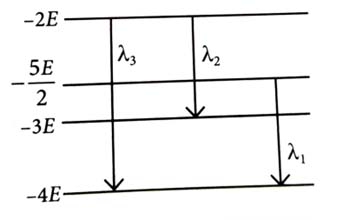Topic Question Set
Q 1
:
A particle of mass is moving around the origin with a constant force pulling it towards the origin. If Bohr model is used to describe its motion, the radius of the orbit and the particle’s speed in the orbit depend on as [2025]
(1)
As force (F) is constant, so
We can write,
As force is constant, so
Using, we get
Also,
As so
or
Q 2
:
A model for quantized motion of an electron in a uniform magnetic field states that the flux passing through the orbit of the electron is where is an integer, is Planck's constant and is the magnitude of electron’s charge. According to the model, the magnetic moment of an electron in its lowest energy state will be ( is the mass of the electron) [2025]
(4)
Flux,
or ...(i)
Also, ...(ii)
Let magnetic moment of electron in circular orbit of an atom be .
...(iii)
where is the mass of electron and is angular momentum.
From eq. (iii),
or
or
Q 3
:
Some energy levels of a molecule are shown in the figure with their wavelengths of transitions. Then [2024]


(4)
As, and
...(i)
...(ii)
...(iii)
From equation (i), (ii) and (iii)
Q 4
:
The ground state energy of hydrogen atom is −13.6 eV. The energy needed to ionize hydrogen atom from its second excited state will be [2023]
13.6 eV
6.8 eV
1.51 eV
3.4 eV
(3)
The energy of state in the hydrogen atom will be
For
So, ionization energy will be,
Q 5
:
The angular momentum of an electron moving in an orbit of hydrogen atom is . The energy in the same orbit is nearly [2023]
eV
eV
eV
eV
(1)
For angular momentum
Hence,
Q 6
:
The radius of innermost orbit of hydrogen atom is . What is the radius of third allowed orbit of hydrogen atom? [2023]
1.59
4.77
0.53
1.06
(2)
Given,
Radius of orbit of Hydrogen atom is,
The radius of the third allowed orbit of hydrogen atom is,
Q 7
:
Let and be the energy of an electron in the first and second excited states of hydrogen atom, respectively. According to the Bohr's model of an atom, the ratio is [2022]
1 : 4
4 : 1
4 : 9
9 : 4
(4)
For excited state, n = 2
For excited state, n = 3
Q 8
:
For which one of the following, Bohr model is not valid? [2020]
Hydrogen atom
Singly ionised helium atom
Deuteron atom
Singly ionised neon atom
(4)
Bohr’s atomic model is valid for single electron species only. A singly ionised neon contains more than one electron. Hence option (4) is correct.
Q 9
:
The total energy of an electron in an atom in an orbit is −3.4 eV. Its kinetic and potential energies are, respectively [2019]
3.4 eV, 3.4 eV
−3.4 eV, −3.4 eV
−3.4 eV, −6.8 eV
3.4 eV, −6.8 eV
(4)
Total energy of electron in orbit,
Kinetic energy of electron in orbit,
Potential energy of electron in orbit,
Thus, total energy of electron,
Q 10
:
The radius of the first permitted Bohr orbit for the electron, in a hydrogen atom equals and its ground state energy equals . If the electron in the hydrogen atom is replaced by muon [charge same as electron and mass ], the first Bohr radius and ground state energy will be [2019]
(3)
Given, radius of first Bohr orbit for electron in a hydrogen atom,
and its ground state energy,
Charge of muon = charge of electron
Mass of muon = 207(mass of electron)
Therefore, when electron is replaced by muon, then first Bohr radius, and ground state energy,

